Selected Indices of Anaerobic Capacity and Their Changes during Special Judo Fitness Tests at Different Ambient Temperatures Performed among Judo Athletes
Abstract
1. Introduction
2. Materials and Methods
2.1. Participants
2.2. General Experimental Design
2.3. Preliminary Study
2.4. Measurement Technique
2.5. Statistical Methods
3. Results
3.1. Peak Power during Repeated Anaerobic Exercise Performed by the Lower Limbs (LL) and Upper Limbs (UL) at 21 °C and 31 °C
3.2. Results of Total Work in Repeated Anaerobic Exercise at 21 °C and 31 °C Performed by the Lower (TWLL) and Upper Limbs (TWUL) and Values of Its Sum (TTW)
3.3. Selected Blood Biochemical Indices Recorded before and after Pulsating Exercise and before and after Each of 5 Series of This Exercise at 21 °C and 31 °C
4. Discussion
Study Limitations
5. Conclusions
Practical Implications
Author Contributions
Funding
Institutional Review Board Statement
Informed Consent Statement
Data Availability Statement
Conflicts of Interest
References
- Lech, G.; Tyka, A.; Pałka, T.; Krawczyk, A. The physical capacity and the course of fights and the sports level of judo juniors. Arch. Budo. 2010, 6, 1–6. [Google Scholar]
- Pałka, T.; Lech, G.; Tyka, A.; Pilch, W.; Wiecha, S. Wydolność fizyczna i morfologiczna budowa ciała profesjonalnych judoków i nietrenujących mężczyzn. Antropomotoryka 2010, 20, 85–89. [Google Scholar]
- Lopes-Silva, J.P.; Panissa, V.L.G.; Julio, U.F.; Franchini, E. Influence of Physical Fitness on Special Judo Fitness Test Performance. J. Strength Cond. Res. 2021, 35, 1732–1738. [Google Scholar] [CrossRef]
- Błach, W.; Rydzik, Ł.; Błach, Ł.; Cynarski, W.J.; Kostrzewa, M.; Ambroży, T. Characteristics of Technical and Tactical Preparation of Elite Judokas during the World Championships and Olympic Games. Int. J. Environ. Res. Public Health 2021, 18, 5841. [Google Scholar] [CrossRef] [PubMed]
- Lech, G.; Sterkowicz, S. The commencement age of training and its effects on technical preferences and achievements attained by judo contestants. Hum. Mov. 2004, 5, 42–47. [Google Scholar]
- Lech, G.; Tyka, A.; Pałka, T.; Krawczyk, R. The physical efficiency and the course of fights and the sports level of judo contestants. Med. Sport Pract. 2007, 8, 81–85. [Google Scholar]
- Pałka, T.; Błach, W.; Lech, G.; Pilch, W.; Tyka, A.; Mucha, D.; Tota, Ł.; Ambroży, T.; Skalska-Izdebska, R. Differences in the levels of physiologicalbiochemical responses during physical exercise involving the lower and upper extremities in judo competitors. J. Combat Sport. Martial Arts 2016, 7, 7–15. [Google Scholar] [CrossRef]
- Rydzik, Ł. Indices of technical and tactical training during kickboxing at different levels of competition in the K1 Formula. J. Kinesiol. Exerc. Sci. 2022, 31, 1–5. [Google Scholar] [CrossRef]
- Ouergui, I.; Hammouda, O.; Chtourou, H.; Gmada, N.; Franchini, E. Effects of recovery type after a kickboxing match on blood lactate and performance in anaerobic tests. Asian J. Sports Med. 2014, 5, 99–107. [Google Scholar]
- Franchini, E.; Sterkowicz, S.; Szmatlan-Gabrys, U.; Gabrys, T.; Garnys, M. Energy System Contributions to the Special Judo Fitness Test. Int. J. Sports Physiol. Perform. 2011, 6, 334–343. [Google Scholar] [CrossRef]
- Górski, J. Fizjologia wysiłku i treningu fizycznego. Wydaw. Lek. PZWL 2019, 28, 74–148. [Google Scholar]
- Almeida, H., Jr.; de Andrade Bastos, A.; Martins, F.J.A.; de Souza, R.F.; Martins, C.O.D.; da Silva, A.G.; Sousa, T.A.; Regi, R.P. Comparison of the thermal profile of Judokas and Brazilian Jiu-Jitsu athletes. J. Phys. Educ. Sport 2019, 19, 3–7. [Google Scholar] [CrossRef]
- Thomas, S.G.; Cox, M.H.; LeGal, Y.M.; Verde, T.J.; Smith, H.K. Physiological profiles of the Canadian National Judo Team. Can. J. Sport Sci. 1989, 14, 142–147. [Google Scholar] [PubMed]
- Quintero, A.M.; da Orssatto, L.B.R.; Pulgarín, R.D.; Follmer, B. Physical performance, body composition and somatotype in Colombian judo athletes. Ido Mov. Cult. 2019, 19, 56–63. [Google Scholar] [CrossRef]
- Little, N.G. Physical performance attributes of junior and senior women, juvenile, junior, and senior men judokas. J. Sports Med. Phys. Fit. 1991, 31, 510–520. [Google Scholar]
- Franchini, E.; Julio, U.F.; Panissa, V.L.G.; Lira, F.S.; Gerosa-Neto, J.; Branco, B.H.M. High-Intensity Intermittent Training Positively Affects Aerobic and Anaerobic Performance in Judo Athletes Independently of Exercise Mode. Front. Physiol. 2016, 7, 268. [Google Scholar] [CrossRef]
- Lech, G.; Jaworski, J.; Krawczyk, R. The Level of Motor Co-Ordination Abilities and the Course of Fights as Well as the Level of Achievements by Senior Judoists. J. Kinesiol. Exerc. Sci. 2007, 17, 63–71. [Google Scholar]
- Wolska, B.; Smulskij, V.; Jagiełło, W. The Level of Aerobic and Anaerobic Capacity and the Results of a Special Mobility Fitness Test of Female Judo Contestants. Balt. J. Health Phys. Act. 2009, 1, 4858. [Google Scholar] [CrossRef]
- Lech, G.; Tyka, A.; Pałka, T.; Krawczyk, R. Effect of physical endurance on fighting and the level of sports per formance in junior judokas. Arch. Budo. 2010, 6, 1–6. [Google Scholar]
- Armstrong, L.E.; Maresh, C.M. The Induction and Decay of Heat Acclimatisation in Trained Athletes. Sport. Med. 1991, 12, 302–312. [Google Scholar] [CrossRef]
- Åstrand, P.O.; Rodahl, K. Textbook of Work Physiology: Physiological Bases of Exercise, 3rd ed.; Mc Graw-Hill: New York, NY, USA, 1986. [Google Scholar]
- Kubica, R.; Tyka, A.; Żuchowicz, A.; Jałocha, W.; Pałka, T.M.B. The effect of different ambient temperature conditions on the level of threshold (AT–TDMA). Med. Sport. 1998, 2, 90–91. [Google Scholar]
- Pałka, T.; Tyka, A.; Maciejczyk, M.; Bawelski, M.; Cisoń, T.; Pilch, W.; Żmuda, M. Wpływ treningu fizycznego o intensywności podprogowej w dwóch różnych temperaturach otoczenia na sprawność wysiłkowych mechanizmów termoregulacyjnych u mężczyzn. Med. Sport. 2006, 4, 79–82. [Google Scholar]
- Alm, P.; Yu, J.G. Physiological characters in mixed martial arts. Am. J. Sport. Sci. 2013, 1, 12–17. [Google Scholar] [CrossRef]
- Bompa, T.O.; Buzzichelli, C.A. Periodization: Theory and Methodology of Training; Human Kinetics: Champaign, IL, USA, 2018. [Google Scholar]
- Åstrand, P.O.; Saltin, B. Maximal oxygen uptake and heart rate in various types of muscular activity. J. Appl. Physiol. 1961, 16, 977–981. [Google Scholar] [CrossRef] [PubMed]
- Kubica, R. Fizjologiczna Analiza Wybranych Wysiłkowych Mechanizmów Adaptacyjnych; Zdrowie i Kultura Fizyczna—Warsztaty Badawcze; AWF Warszawa: Warszawa, Poland, 1989. [Google Scholar]
- Sterkowicz, S.; Zuchowicz, A.; Kubica, R. Levels of anaerobic capacity and results for Special Judo Fitness test in judo competitors. J. Hum. Kin. 1999, 2, 115–135. [Google Scholar]
- Pałka, T.; Lech, G.; Tyka, A.; Tyka, A.; Sterkowicz-Przybycień, K.; Sterkowicz, S.; Cebula, A.; Stawiarska, A. Differences in the level of anaerobic and aerobic components of physical capacity in judoists at different age. Arch. Budo. 2013, 9, 195–203. [Google Scholar]
- Lawler, J.; Powers, S.K.; Dodd, S. A time-saving incremental cycle ergometer protocol to determine peak oxygen consumption. Br. J. Sports Med. 1987, 21, 171–173. [Google Scholar] [CrossRef]
- Tyka, A.; Żuchowicz, A.; Kubica, R.P.T. Effect of ambient temperature on mechanical power at anaerobic threshold. Med. Sci. Sport. Exerc. 2000, 32, 155. [Google Scholar]
- Sterkowicz, S.; Maslej, P. Analiza przebiegu walki judo na podstawie jej struktury czasowej-badania porównawcze. Sport Wyczyn. 1999, 37, 33–38. [Google Scholar]
- Chtourou, H.; Aloui, A.; Hammouda, O.; Chaouachi, A.; Chamari, K.; Souissi, N. The effect of time-of-day and judo match on short-term maximal performances in judokas. Biol. Rhythm. Res. 2013, 44, 797–806. [Google Scholar] [CrossRef]
- Ceylan, B.; Barley, O.R.; Balci, S.S. Changes in body mass and hydration status in judo athletes before and after a top-level competition: A descriptive case study. Phys. Sportsmed. 2022. [Google Scholar] [CrossRef] [PubMed]
- Ceylan, B.; Taşcan, M.B.; Simenko, J.; Balcı, Ş.S. Habit or lack of education? Hypohydration is present in elite senior judo athletes even during a weight-stable training camp. Int. J. Sports Sci. Coach. 2022, 174795412211224. [Google Scholar] [CrossRef]
- Pałka, T.; Lech, G.; Tota, Ł.; Tyka, A.; Pilch, W.; Mucha, D.; Bujas, P.; Ambroży, T.; Renata, S.-I.; Tyka, A. The level of selected indicators of anaerobic capacity in judo players and the range of their changes during simulated tournament fights. In Proceedings of the Third International Scientific Conference “Motor Abilities in Sports—Theoretical Assumptions and Practical Implications”, Kraków, Poland, 19–21 September 2019. [Google Scholar]
- Szyguła, Z. Profilaktyka i postępowanie w schorzeniach spowodowanych wysiłkiem w gorącym otoczeniu. Med. Sport. 1997, 1, 55–57. [Google Scholar]
- Gomes Moreira, D.; José Brito, C.; de Almeida Ferreira, J.J.; Bouzas Marins, J.C.; López Díaz de Durana, A.; Couceiro Canalejo, J.; Butragueño Revenga, J.; Sillero-Quintana, M. Lactate Concentration Is Related to Skin Temperature Variation after a Specific Incremental Judo Test. J. Strength Cond. Res. 2021, 35, 2213–2221. [Google Scholar] [CrossRef] [PubMed]
- Du Bois, D.; Du Bois, E.F. A formula to estimate the approximate surface area if height and weight be kno. Arch. Int. Med. 1916, 17, 863–871. [Google Scholar] [CrossRef]
- Dotan, R.; Bar-Or, O. Load optimization for the wingate anaerobic test. Eur. J. Appl. Physiol. Occup. Physiol. 1983, 51, 409–417. [Google Scholar] [CrossRef]
- Stanisz, A. Przystępny Kurs Statystyki; StatSoft Polska Sp. z o.o.: Kraków, Poland, 2001. [Google Scholar]
- Ferretti, G.; Ishii, M.; Moia, C.; Cerretelli, P. Effects of temperature on the maximal instantaneous muscle power of humans. Eur. J. Appl. Physiol. Occup. Physiol. 1992, 64, 112–116. [Google Scholar] [CrossRef]
- Nielsen, B. Termoregulation in reast end exercise. Acta Physiol. Scand. Suppl. 1969, 323, 1–74. [Google Scholar]
- Gleeson, M. Temperature Regulation during Exercise. Int. J Sport. Med. 1998, 19, 96–99. [Google Scholar] [CrossRef]
- Lech, G.; Sterkowicz, S.; Żuchowicz, A.R.W. Wydolność fizyczna a przebieg i rezultaty walki judo juniorów. Ann. Univ. Mariae Curie-Skłodowska 2006, 60, 190–193. [Google Scholar]
- Franchini, E.; Del Vecchio, F.B.; Matsushigue, K.A.; Artioli, G.G. Physiological Profiles of Elite Judo Athletes. Sport. Med. 2011, 41, 147–166. [Google Scholar] [CrossRef]
- Bar-Or, O. The Wingate Anaerobic Test an Update on Methodology, Reliability and Validity. Sport. Med. Int. J. Appl. Med. Sci. Sport Exerc. 1987, 4, 381–394. [Google Scholar] [CrossRef]
- Sikorski, W.; Mickiewicz, G.; Majle, B. Łaksa Cz. Struktura walki judo i jej wpływ na wydolność zawodnika. Sport Wyczyn. 1988, 9, 15–19. [Google Scholar]
- Mickiewicz, G.; Starczewska, G.; Borkowski, L. Fizjologiczna charakterystyka zawodników kadry narodowej judo. Sport Wyczyn. 1988, 9, 46–50. [Google Scholar]
- Zdanowicz, R.; Wojczuk, J. Wydolność beztlenowa zawodników i zawodniczek judo. Sport Wyczyn. 1984, 12, 29–36. [Google Scholar]
- Franchini, E.; Takito, M.Y. Physical Fitness and Anthropometrical Differences. Biol. Sport 2005, 22, 315–328. [Google Scholar]
- Sharp, N.C.C.; Koutedakis, Y. Anaerobic power and capacity measurements of the upper body in elite judo players, gymnasts and rowers. Aust. J. Sei. Med. Sport. 1987, 19, 9–13. [Google Scholar]
- Hübner-Wozniak, E.; Kosmol, A.; Lutoslawska, G.; Bem, E. Anaerobic performance of arms and legs in male and female free style wrestlers. J. Sci. Med. Sport 2004, 7, 473–480. [Google Scholar] [CrossRef]
- Sikorski, W.; Łaksa, C. Analiza Mistrzostw Świata w Judo–Maastricht (Holandia) 1981. Sport Wyczyn. 1982, 4, 28–35. [Google Scholar]
- Vidal Andreato, L.; Franzói de Moraes, S.M.; Lopes de Moraes Gomes, T.; Del Conti Esteves, J.V.; Vidal Andreato, T.; Franchini, E. Estimated aerobic power, muscular strength and flexibility in elite Brazilian Jiu-Jitsu athletes. Sci. Sports 2011, 26, 329–337. [Google Scholar] [CrossRef]
- Sterkowicz, S.; Lech, G.; Blecharz, J. Effects of laterality on the technical/tactical behavior in view of the results of judo fights. Arch. Budo. 2010, 6, 173–177. [Google Scholar]
- Chwała, W.; Ambroży, T.; Sterkowicz, S. Three-dimensional analysis of the ju-jitsu competitors’ motion during the performance of the ippon-seoi-nage throw. Arch. Budo. Sci. Martial Arts Extrem. Sport. 2013, 9, 41–53. [Google Scholar]
- Tyka, A.; Wiecha, S.; Pałka, T.; Cisoń, T.; Szyguła, Z.; Tyka, A. Effects of Ambient Temperature on Physiological Responses to Incremental Exercise Test. J. Hum. Kinet. 2010, 26, 57–64. [Google Scholar] [CrossRef]
- Pałka, T.; Tyka, A.; Maciejczyk, M.; Cisoń, T.; Pilch, W.; Żmuda, M. Effect of Physical training in two different temperatures on exercise thermoregulation in men. Med. Sport Pract. 2006, 7, 79–82. [Google Scholar]
- Cisoń, T. Wpływ Odwodnienia Wysiłkowego Oraz Różnych Strategii Nawadniania Organizmu Podczas Pracy Fizycznej i po Wysiłku na Wielkość Mocy Maksymalnej i Wybranych Wskaźników Fizjologiczno-Biochemicznych Krwi. Ph.D. Thesis, University of Physical Education, Kraków, Poland, 2010. [Google Scholar]
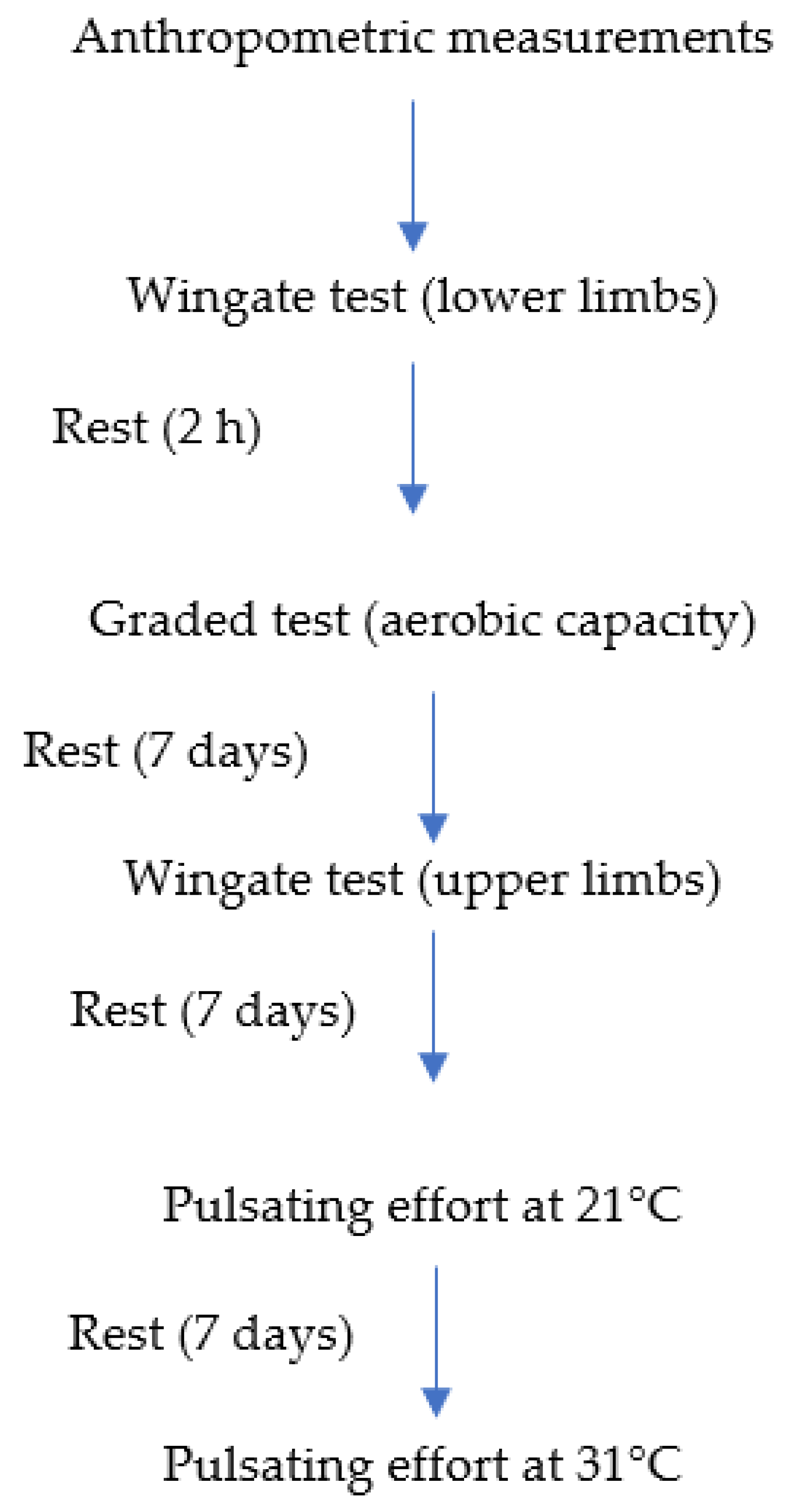
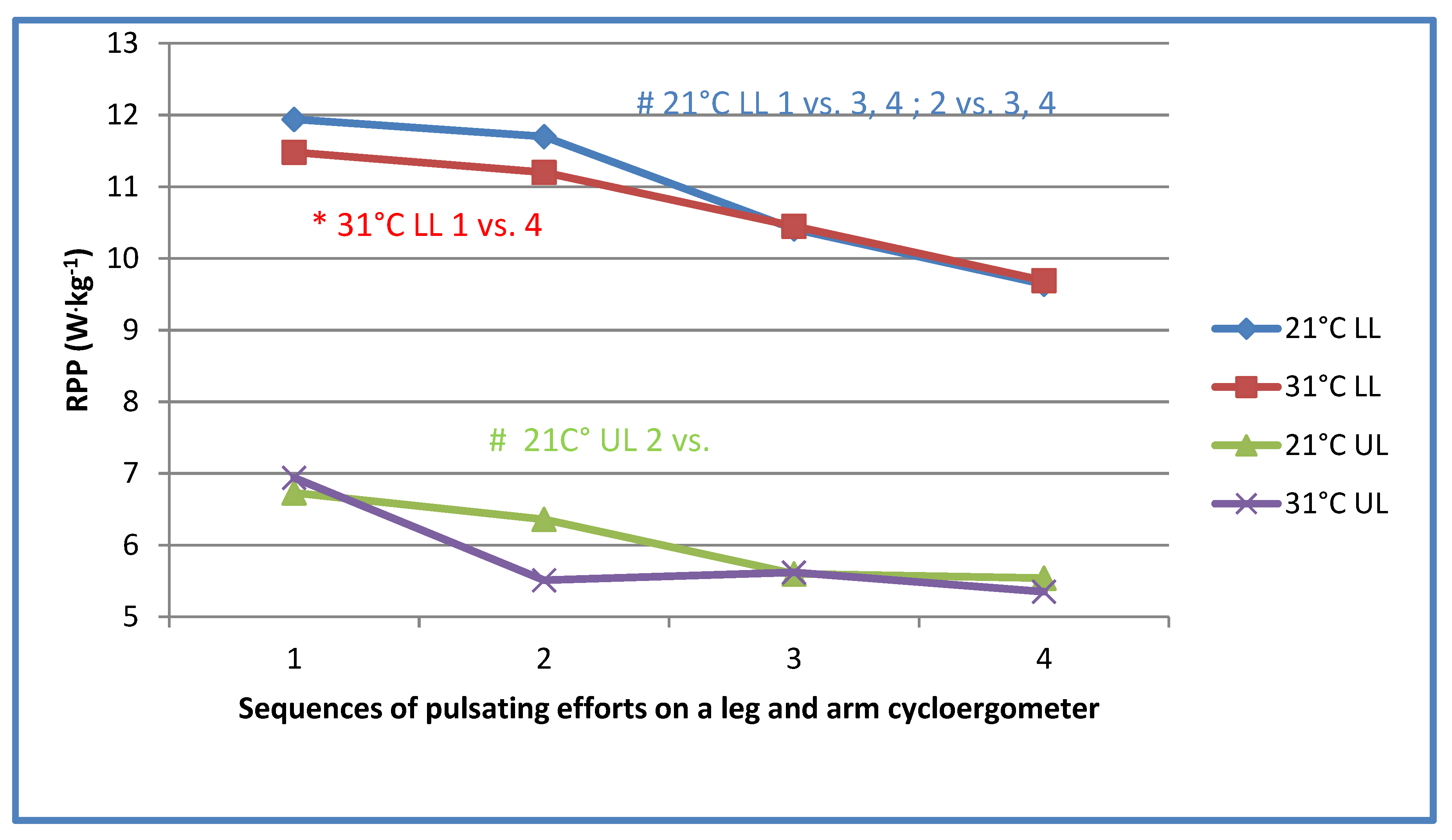
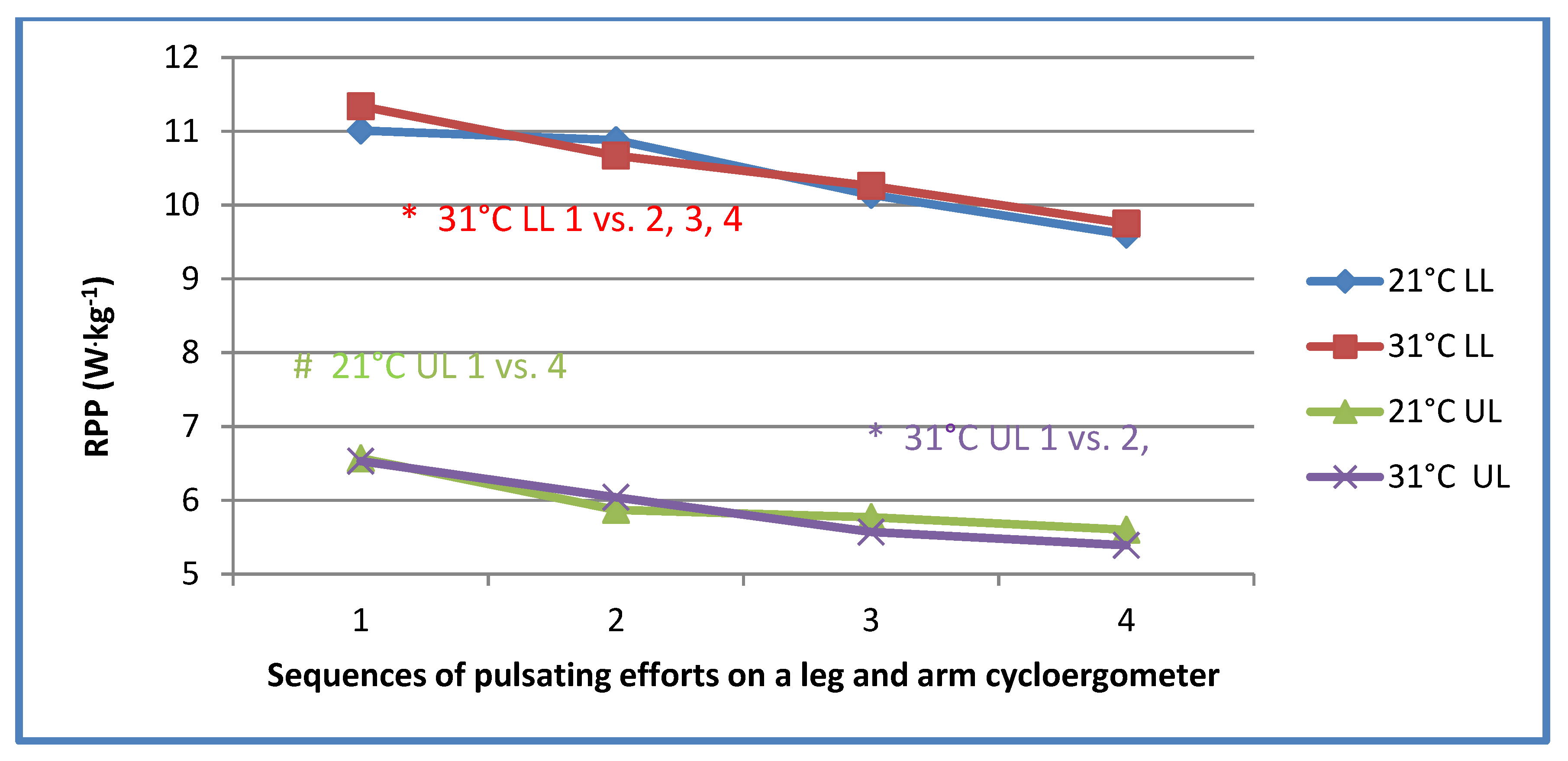
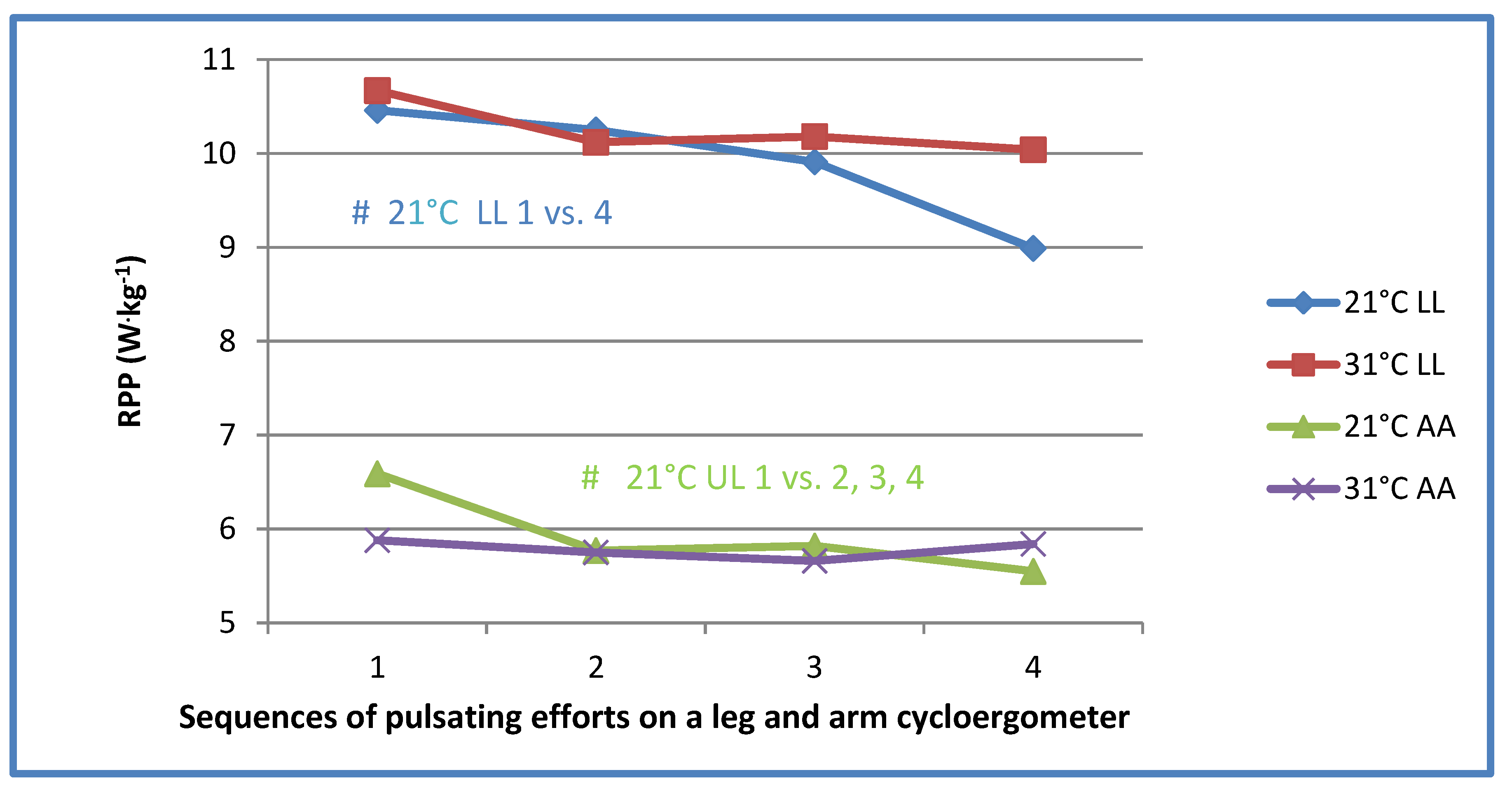
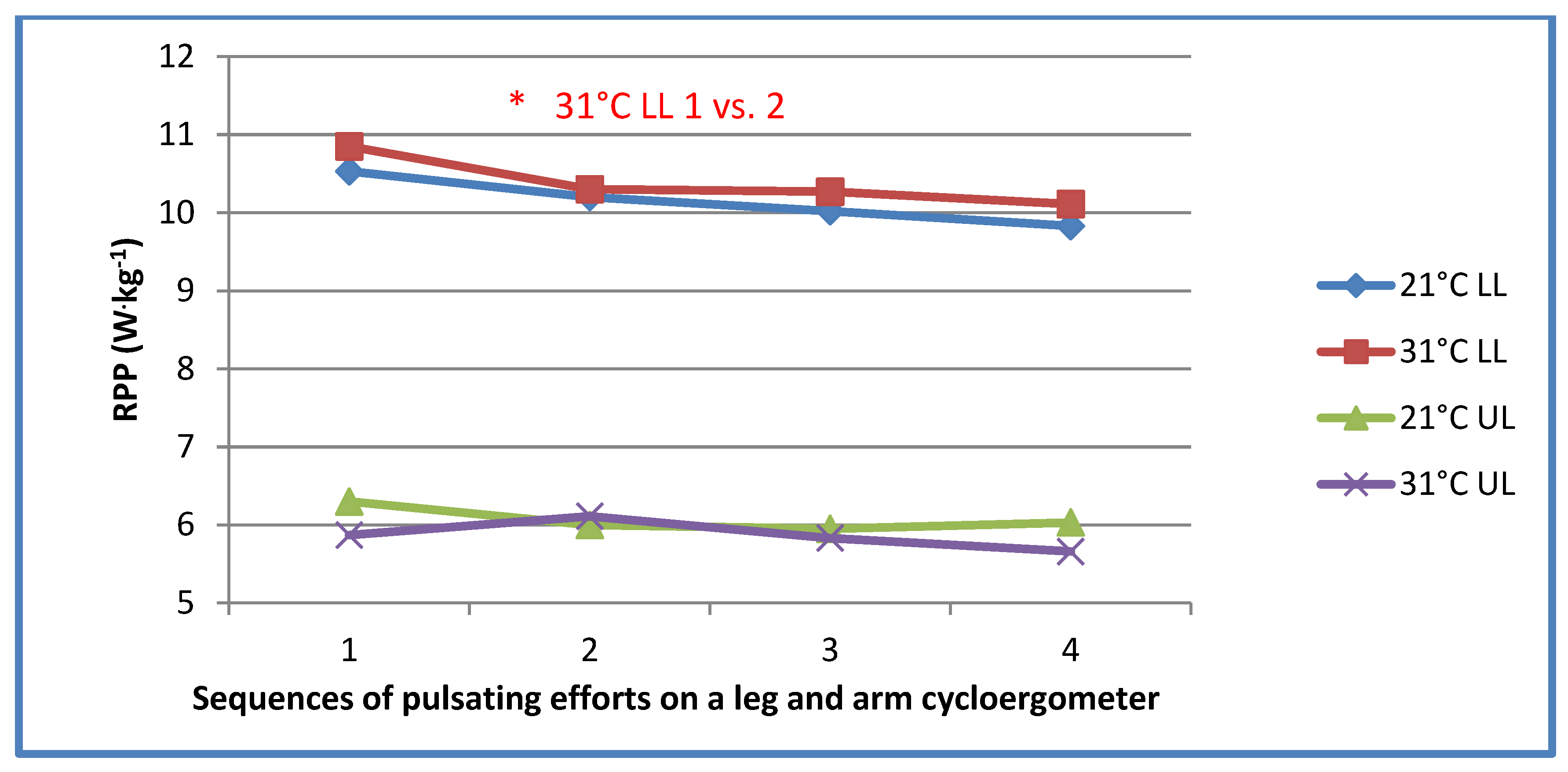
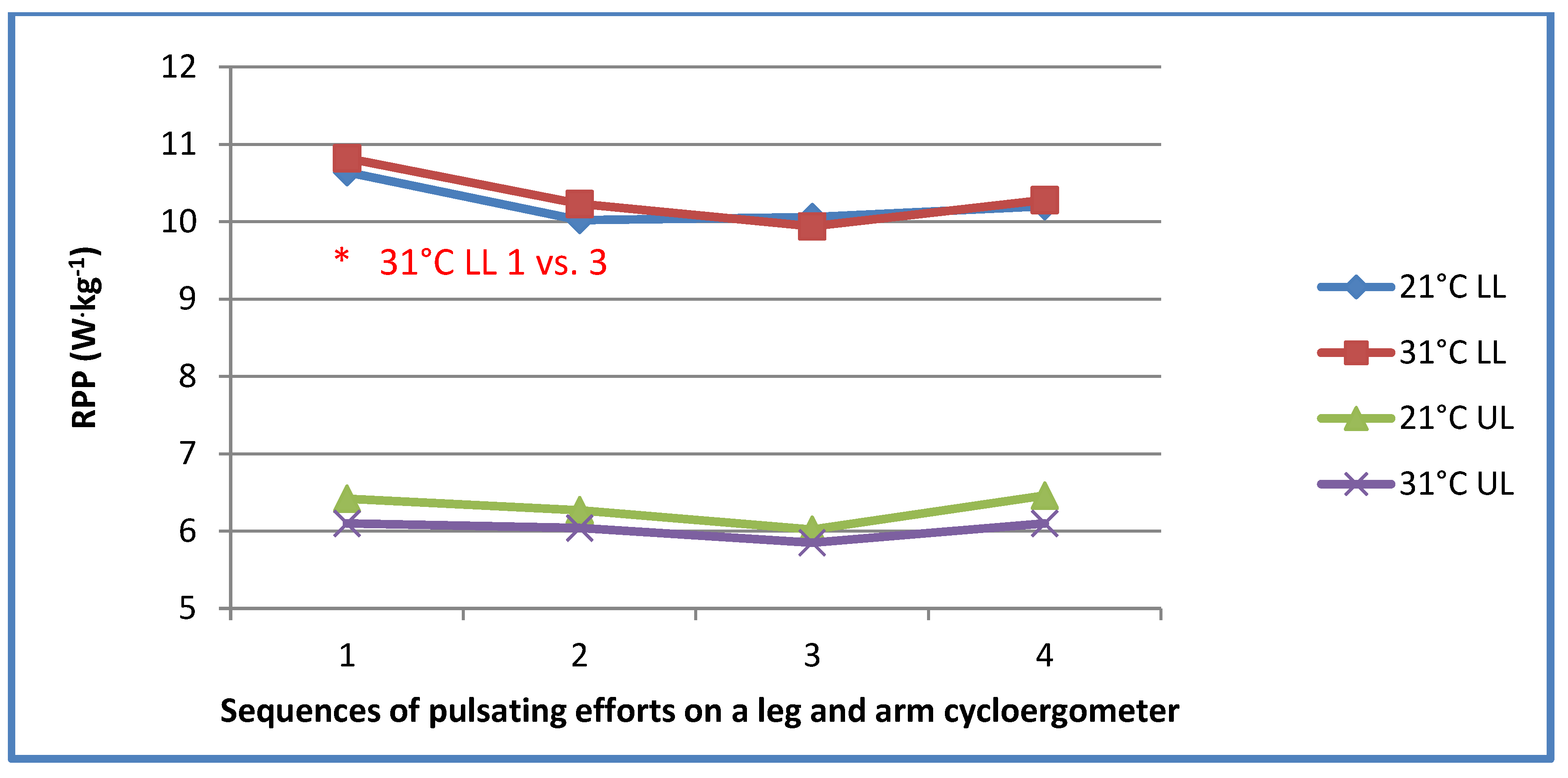
| 20 Professional Judo Competitors | |
|---|---|
| Included: 15 | Excluded: 5 |
| Inclusion criteria | Exclusion criteria |
| Age > 18 years | Age < 18 years |
| Good Health Status—Status Determined on the Basis of a Medical Examination by a Sports Physician | Diseases and injuries |
| High sports skill level | Low sports skill level |
| Training experience >10 years | Too short training experience |
| At least 5th place in national competitions | No success in national competitions |
| Examination started by 15 participants | |
| Full scope of tests completed by 10 participants | Full scope of tests not completed by 5 participants |
| NNLL | Interval | UL | Interval | LL | Interval | UL | Interval | LL | Interval | UL | Interval | LL | Interval | UL | Interval |
|---|---|---|---|---|---|---|---|---|---|---|---|---|---|---|---|
| 15 s | 30 s | 15 s | 30 s | 30 s | 60 s | 30 s | 60 s | 20 s | 45 s | 20 s | 45 s | 15 s | 30 s | 15 s | 30 s |
| Temperature | Measurement | SD | |
|---|---|---|---|
| 21 °C | Before | 74.68 | 11.32 |
| After | 73.70 # | 10.99 | |
| 31 °C | Before | 74.87 | 11.29 |
| After | 73.31 * | 11.12 |
| No. | 21 °C | 31 °C | ||||
|---|---|---|---|---|---|---|
| TWLL (kJ) | TWUL (kJ) | ∑TW (kJ) | TWLL (kJ) | TWUL (kJ) | ∑TW (kJ) | |
| 1 | 386.6 | 220.6 | 607.2 | 386.9 | 224.4 | 611.3 |
| 2 | 367.7 | 212.4 | 580.1 | 375.6 | 214.7 | 590.2 |
| 3 | 352.4 | 212.3 | 564.8 | 365.2 | 207.4 | 572.6 |
| 4 | 350.3 | 218.1 | 568.4 | 367.6 | 213.3 | 580.8 |
| 5 | 349.7 | 225.0 | 574.7 | 358.4 | 214.7 | 573.1 |
| ∑ | 1806.8 | 1088.5 | 2895.2 | 1853.7 | 1074.3 | 2928.0 |
| LA (mmol·L−1) | Rest | After 1st Effort | Before 2nd Effort | After 2nd Effort | Before 3rd Effort | After 3rd Effort | Before 4th Effort | After 4th Effort | Before 5th Effort | After 5th Effort | |
|---|---|---|---|---|---|---|---|---|---|---|---|
| 21 °C | After 1st effort | <0.001 | |||||||||
| Before 2nd effort | <0.001 | <0.001 | |||||||||
| After 2nd effort | <0.001 | 0.534 | <0.001 | ||||||||
| Before 3rd effort | <0.001 | <0.001 | 0.825 | <0.001 | |||||||
| After 3rd effort | <0.001 | 0.474 | <0.001 | 0.498 | <0.001 | ||||||
| Before 4th effort | <0.001 | <0.002 | 0.296 | <0.001 | 0.412 | <0.001 | |||||
| After 4th effort | <0.001 | 0.414 | <0.001 | 0.363 | <0.001 | 0.478 | <0.002 | ||||
| Before 5th effort | <0.001 | <0.001 | 0.044 | <0.001 | 0.130 | <0.001 | 0.081 | <0.001 | |||
| After 5th effort | <0.001 | 0.202 | <0.001 | 0.087 | 0.002 | 0.266 | <0.001 | 0.584 | <0.001 | ||
| After 1 h | <0.001 | <0.001 | <0.001 | <0.001 | <0.001 | <0.001 | <0.001 | <0.001 | <0.001 | <0.001 | |
| 31 °C | After 1st effort | <0.001 | |||||||||
| Before 2nd effort | <0.001 | <0.001 | |||||||||
| After 2nd effort | <0.001 | 0.014 | <0.001 | ||||||||
| Before 3rd effort | <0.001 | <0.001 | 0.922 | <0.001 | |||||||
| After 3rd effort | <0.001 | 0.010 | <0.001 | 0.460 | <0.001 | ||||||
| Before 4th effort | <0.001 | 0.002 | 0.480 | <0.001 | 0.368 | <0.001 | |||||
| After 4th effort | <0.001 | 0.539 | <0.001 | 0.500 | 0.002 | 0.194 | <0.001 | ||||
| Before 5th effort | <0.001 | <0.001 | 0.757 | <0.001 | 0.873 | <0.001 | 0.094 | <0.001 | |||
| After 5th effort | <0.001 | 0.555 | 0.004 | 0.152 | 0.015 | 0.032 | 0.002 | 0.118 | <0.001 | ||
| After 1 h | <0.001 | <0.001 | <0.001 | <0.001 | <0.001 | <0.001 | <0.001 | <0.001 | <0.001 | <0.001 | |
| Measurement | p |
|---|---|
| sp | 0.314 |
| After 1st effort | 0.382 |
| Before 2nd effort | 0.649 |
| After 2nd effort | 0.662 |
| Before 3rd effort | 0.751 |
| After 3rd effort | 0.481 |
| Before 4th effort | 0.537 |
| After 4th effort | 0.871 |
| Before 5th effort | 0.409 |
| After 5th effort | 0.748 |
| After 1 h | <0.001 |
Publisher’s Note: MDPI stays neutral with regard to jurisdictional claims in published maps and institutional affiliations. |
© 2022 by the authors. Licensee MDPI, Basel, Switzerland. This article is an open access article distributed under the terms and conditions of the Creative Commons Attribution (CC BY) license (https://creativecommons.org/licenses/by/4.0/).
Share and Cite
Pałka, T.; Lech, G.; Pilch, W.; Tota, Ł.; Koteja, P.; Tyka, A.; Czech, P.; Rydzik, Ł.; Ambroży, T. Selected Indices of Anaerobic Capacity and Their Changes during Special Judo Fitness Tests at Different Ambient Temperatures Performed among Judo Athletes. Appl. Sci. 2022, 12, 12640. https://doi.org/10.3390/app122412640
Pałka T, Lech G, Pilch W, Tota Ł, Koteja P, Tyka A, Czech P, Rydzik Ł, Ambroży T. Selected Indices of Anaerobic Capacity and Their Changes during Special Judo Fitness Tests at Different Ambient Temperatures Performed among Judo Athletes. Applied Sciences. 2022; 12(24):12640. https://doi.org/10.3390/app122412640
Chicago/Turabian StylePałka, Tomasz, Grzegorz Lech, Wanda Pilch, Łukasz Tota, Piotr Koteja, Anna Tyka, Piotr Czech, Łukasz Rydzik, and Tadeusz Ambroży. 2022. "Selected Indices of Anaerobic Capacity and Their Changes during Special Judo Fitness Tests at Different Ambient Temperatures Performed among Judo Athletes" Applied Sciences 12, no. 24: 12640. https://doi.org/10.3390/app122412640
APA StylePałka, T., Lech, G., Pilch, W., Tota, Ł., Koteja, P., Tyka, A., Czech, P., Rydzik, Ł., & Ambroży, T. (2022). Selected Indices of Anaerobic Capacity and Their Changes during Special Judo Fitness Tests at Different Ambient Temperatures Performed among Judo Athletes. Applied Sciences, 12(24), 12640. https://doi.org/10.3390/app122412640










